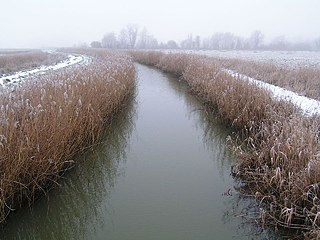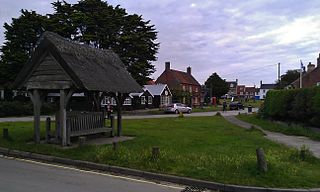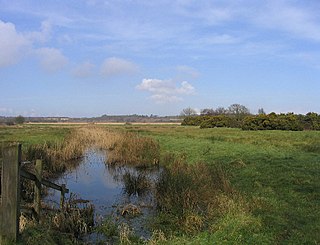| Site of Special Scientific Interest | |
Dingle Marshes, part of the Minsmere–Walberswick Heaths and Marshes SSSI | |
| Area of Search | Suffolk |
|---|---|
| Grid reference | TM469681 |
| Coordinates | 52°15′22″N1°37′01″E / 52.256°N 1.617°E Coordinates: 52°15′22″N1°37′01″E / 52.256°N 1.617°E |
| Interest | Biological |
| Area | 2,325.89 hectares (23 km2; 9.0 sq mi) |
| Notification | 1993 |
| Natural England website | |
Minsmere–Walberswick Heaths and Marshes are a Special Area of Conservation and Site of Special Scientific Interest in the English county of Suffolk. [1] The site is located on the North Sea coast between Southwold and Sizewell, extending over an area of coastline around 7 miles (11 km) in length. The site is also designated as a Special Protection Area, [2] part of the Minsmere–Walberswick European Marine Site and contains areas designated as Ramsar sites and Natura 2000 sites. [3] It lies within the Suffolk Coast and Heaths Area of Outstanding Natural Beauty [4] and is made up of a "complex mosaic" of marshes, reed beds, shingle banks and lowland heath habitats. [2]
A Special Area of Conservation (SAC) is defined in the European Union's Habitats Directive (92/43/EEC), also known as the Directive on the Conservation of Natural Habitats and of Wild Fauna and Flora. They are to protect the 220 habitats and approximately 1000 species listed in annex I and II of the directive which are considered to be of European interest following criteria given in the directive. They must be chosen from the Sites of Community Importance by the State Members and designated SAC by an act assuring the conservation measures of the natural habitat.

A Site of Special Scientific Interest (SSSI) in Great Britain or an Area of Special Scientific Interest (ASSI) in the Isle of Man and Northern Ireland is a conservation designation denoting a protected area in the United Kingdom and Isle of Man. SSSI/ASSIs are the basic building block of site-based nature conservation legislation and most other legal nature/geological conservation designations in the United Kingdom are based upon them, including national nature reserves, Ramsar sites, Special Protection Areas, and Special Areas of Conservation. The acronym "SSSI" is often pronounced "triple-S I".

Suffolk is an East Anglian county of historic origin in England. It has borders with Norfolk to the north, Cambridgeshire to the west and Essex to the south. The North Sea lies to the east. The county town is Ipswich; other important towns include Lowestoft, Bury St Edmunds, Newmarket and Felixstowe, one of the largest container ports in Europe.
Contents
The SSSI covers an area of 2,325.89 hectares (8.98 sq mi; 23.26 km2). [5] It is a composite site and was formed by the almagamation of the Minsmere Level, Walberswick and Brick Kiln Walks SSSI units. It extends from Hen Reedbeds and Southwold Common north of the River Blyth, through Walberswick and Dunwich to Westleton, Minsmere and Eastbridge to the north of Sizewell nuclear power stations. [6] The area includes the Suffolk Coast National Nature Reserve sites at Hen Reedbeds, Walberswick and Dingle Marshes, the National Trust property at Dunwich Heath and the Minsmere RSPB reserve. It is a Nature Conservation Review site, Grade I, [7] and covers two nature reserves managed by the Suffolk Wildlife Trust, Dingle Marshes [8] and Hen Reedbeds. [9]

Hen Reedbeds is a 55 hectare nature reserve near the North Sea coast of the English county of Suffolk. The reserve is located in the Blyth valley between Reydon and Blythburgh, approximately 2.5 miles (4.0 km) west of Southwold. The marshes make up part of the Suffolk Coast National Nature Reserve along with reserves at Walberswick and Dingle Marshes.

Southwold is a small town and civil parish on the English North Sea coast in the East Suffolk district of Suffolk. It lies at the mouth of the River Blyth within the Suffolk Coast and Heaths Area of Outstanding Natural Beauty. The town is about 11 miles (18 km) south of Lowestoft, 29 miles (47 km) north-east of Ipswich and 97 miles (156 km) north-east of London, within the parliamentary constituency of Suffolk Coastal. The "All Usual Residents" 2011 Census figure gives a total of 1,098 persons for the town. The 2012 Housing Report by the Southwold and Reydon Society concluded that 49 per cent of the dwellings in the town are used as second homes and let to holiday-makers.

The River Blyth is a river in east Suffolk, England. Its source is near Laxfield and it reaches a tidal estuary between Southwold and Walberswick on the North Sea coast.



















